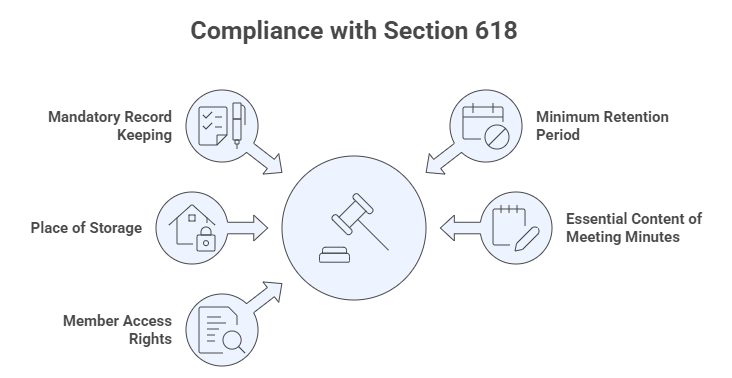For Hong Kong companies, meeting minutes aren’t just administrative paperwork – they are legally mandated records with serious compliance implications. Under Section 618 of the Hong Kong Companies Ordinance (Cap. 622), companies face strict requirements for creating, storing, and disclosing minutes of general meetings and resolutions. Failure to comply isn’t an oversight; it’s a criminal offence carrying significant penalties. Understanding exactly what must be disclosed and how is crucial for directors and company secretaries.

Demystifying Section 618: The Core Requirements
Section 618 imposes several non-negotiable obligations on all Hong Kong incorporated companies:
- Mandatory Record Keeping: Companies must keep records comprising:
- Copies of all resolutions of members passed otherwise than at general meetings (e.g., written resolutions).
- Minutes of all proceedings of general meetings (AGMs, EGMs).
- All written records provided under Section 617(2) (decisions by a sole member).
- Minimum Retention Period: These records must be kept for at least 10 years. The clock starts from:
- The date of the resolution.
- The date of the meeting.
- The date of the sole member’s decision.
- Place of Storage: Records must be kept at:
- The company’s registered office in Hong Kong; or
- A “prescribed place” in Hong Kong (as defined by regulations). The Registrar must be notified within 15 days if records are kept at a place other than the registered office, or if that place changes.
- Essential Content of Meeting Minutes (Section 618(1)(b) & Implied Requirements):
While the Ordinance doesn’t prescribe an exhaustive minute-by-minute script, Section 618, combined with common law and best practices, dictates that minutes must accurately reflect key decisions and events to serve as legal evidence. Crucially, minutes must disclose:- Type of Meeting: Clearly state if it’s an AGM, EGM, or class meeting.
- Date, Time, and Place: The specific details of where and when the meeting was held.
- Attendance:
- Names of directors present.
- Names of the chairperson and company secretary (if any).
- Number of members present in person or by proxy (sufficient to establish quorum under Section 585 – typically 2 members, or 1 if it’s a sole member company).
- Quorum Confirmation: A statement that a quorum was present at the commencement of the meeting.
- Notice: Confirmation that proper notice of the meeting was given in accordance with Sections 571-575.
- Resolutions Proposed and Voted On:
- The exact wording of every ordinary resolution, special resolution, or resolution requiring special notice (Section 578) proposed.
- A clear record of how each resolution was decided:
- If by a show of hands: The chairperson’s declaration of the result is typically sufficient (Section 590(1)).
- If by a poll (demanded under Section 591): Minutes MUST include (Section 594(1)):
- The result of the poll (passed/failed).
- The total number of votes that could be cast on the resolution.
- The number of votes cast in favour.
- The number of votes cast against.
- Crucially, the minutes themselves serve as conclusive evidence of these proceedings if signed (Section 621(2) & (3)).
- Substantive Discussions (Key Decisions & Material Facts): While not a verbatim transcript, minutes must accurately record:
- Key points of discussion leading to resolutions.
- Material declarations of interest by directors (even if not strictly required by Section 577 at the notice stage, disclosure in minutes is critical).
- Significant statements or reports presented (e.g., CEO report, financial statements tabled at AGM).
- Appointments or removals of directors, auditors, or company secretaries.
- Specific instructions given to directors or management arising from resolutions.
- The time of adjournment (if applicable).
- Signing: Minutes must be signed by the chairperson of the meeting or by the chairperson of the next meeting (Section 621(2)).
- Member Access Rights (Section 620):
- Any member of the company is entitled, upon request and without charge, to inspect the minutes of general meetings (and other Section 618 records) in accordance with prescribed regulations.
- Any member is entitled, upon request and payment of a prescribed fee, to be provided with a copy of these minutes/records.
Consequences of Non-Compliance: It’s Serious Business
Ignoring Section 618 isn’t an option. The penalties are severe:
- Criminal Offence: Failure to keep the required records (S618(1)), or to keep them for 10 years (S618(2)), or to keep them at the registered office/prescribed place (S618(1) & S619(1)) is an offence.
- Liability: Both the company and every responsible person (typically directors and the company secretary) commit the offence.
- Penalties: Conviction can lead to a fine at level 5 (currently HK$50,000). For continuing offences (e.g., failure to keep records for 10 years), there’s an additional fine of HK$1,000 per day the offence continues (S618(3) & S619(5)).
- Evidence Invalidity: Poorly kept or non-existent minutes severely weaken a company’s position if meeting decisions or procedures are challenged in court or by regulators. Section 621 provides significant protection only if proper minutes exist and are signed.
Compliance vs. Problems: Spotting the Difference
Let’s illustrate the critical differences between compliant and problematic minutes concerning disclosure:
- Scenario 1: Passing an Ordinary Resolution (Appointment of Director)
- Compliant Minute:
> “Item 3: Appointment of Director. The Chairperson proposed the ordinary resolution: ‘THAT Ms. Chan Mei Ling be appointed as a director of the Company with immediate effect.’ The resolution was put to a show of hands. The Chairperson declared the resolution carried.”
> Why Compliant: Clearly states the resolution verbatim and the outcome. Assumes proper quorum/notice confirmed elsewhere in minutes. - Problematic Minute:
> “Item 3: New Director. After discussion, it was agreed to appoint Ms. Chan.”
> The Problem: Fails to state the resolution wording. Doesn’t formally record the vote or its outcome (“agreed” is vague). Lacks specificity about the role and start date.
- Compliant Minute:
- Scenario 2: Special Resolution (Amending Articles) – Decided by Poll
- Compliant Minute (Excerpt):
> “Item 5: Amendment to Articles of Association. The Chairperson read the proposed special resolution (circulated with the notice of meeting): ‘THAT the Articles of Association of the Company be amended by deleting the existing Article 12 and substituting it with the new Article 12 as set out in the Appendix to this resolution.’ Mr. Lee demanded a poll. The poll was duly taken. The results of the poll were recorded by the Company Secretary as follows: Total votes capable of being cast: 100,000. Votes in favour: 78,450. Votes against: 21,550. The Chairperson declared the special resolution carried.”
> Why Compliant: States resolution verbatim. Records demand for poll. Includes all mandatory poll result details (total votes, for, against) as required by S594(1). Clear declaration of outcome. - Problematic Minute:
> “Item 5: Articles Change. The special resolution to change Article 12 was discussed. A poll was held. The resolution was passed by a large majority.”
> The Problem: Doesn’t state the resolution wording. Fails to disclose the critical poll numbers (total votes, for, against) required by law. “Large majority” is insufficient and legally risky.
- Compliant Minute (Excerpt):
- Scenario 3: Director’s Interest in a Transaction (AGM)
- Compliant Minute:
> “Item 7: Related Party Transaction. The proposed contract with ABC Supplier Ltd. was tabled. Director Mr. Wong declared a material interest as he is a majority shareholder of ABC Supplier Ltd. Mr. Wong left the meeting during discussion and voting on this item. The Chairperson confirmed Mr. Wong’s interest and departure were noted. The ordinary resolution ‘THAT the Company enter into the supply contract with ABC Supplier Ltd. on the terms presented’ was proposed, seconded, passed by a show of hands, and declared carried by the Chairperson.”
> Why Compliant: Clearly records the director’s declaration of interest, the nature of the interest, his withdrawal, and the Chair’s acknowledgment. Ensures the decision is documented despite the conflict. - Problematic Minute:
> “Item 7: ABC Supplier Contract. Approved.”
> The Problem: Fails entirely to disclose the director’s conflict of interest and withdrawal. Creates significant risk of the transaction being challenged or the directors facing liability for breach of duty.
- Compliant Minute:
Best Practices for Section 618 Compliance & Robust Disclosure
- Templates are Your Friend (But Customize): Use consistent, comprehensive minute templates covering all Section 618 requirements and best practices. Ensure they capture all mandatory elements.
- Accuracy & Objectivity: Record facts and decisions accurately and objectively. Avoid subjective commentary, opinions, or unnecessary detail. Focus on what was decided, not lengthy debates.
- Detail Resolutions Precisely: Include the exact wording of every resolution proposed and voted on.
- Meticulous Poll Recording: If a poll is demanded, meticulously record the total votes capable of being cast, votes for, and votes against. This is non-negotiable under S594.
- Document Interests: Scrupulously record any director’s declaration of a material interest in a matter being discussed/voted on, and their withdrawal if required.
- Prompt Drafting & Signing: Draft minutes promptly after the meeting while details are fresh. Circulate drafts to key participants (Chair, Company Secretary) for review. Ensure the final version is signed by the Chairperson as soon as practicable.
- Secure Storage: Store signed original minutes securely at the registered office or prescribed place for the full 10-year minimum. Implement robust access controls and backup procedures (especially for electronic records).
- Facilitate Access: Be prepared to handle member inspection and copy requests efficiently and in accordance with Section 620 and relevant regulations. Maintain a log of such requests.
- Regular Reviews: Periodically review minute-taking practices and templates against the Ordinance and best practices. Ensure new directors and secretaries are trained on requirements.
Conclusion: Minutes as a Shield, Not Just a Record
Meeting minutes governed by Section 618 are far more than an administrative chore. They are a critical legal safeguard for Hong Kong companies. Properly drafted, stored, and disclosed minutes provide irrefutable evidence of corporate decisions, demonstrate compliance with statutory procedures, protect directors from unfounded claims, and uphold the rights of members to scrutinize company affairs. Conversely, inadequate or non-compliant minutes expose the company and its officers to significant financial penalties, legal challenges, reputational damage, and operational uncertainty.
Treating minute-taking with the diligence it demands under the law is not just about avoiding fines; it’s about ensuring good governance, maintaining trust, and protecting the company’s legal integrity. For companies navigating complex compliance or requiring verified documentation of Hong Kong entities, professional services specializing in Hong Kong company document retrieval and comprehensive Hong Kong company reports can provide essential support.
